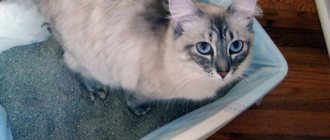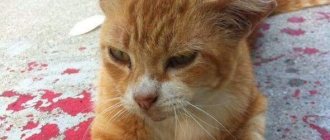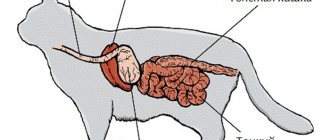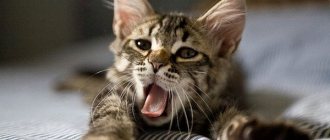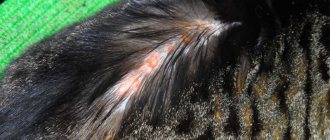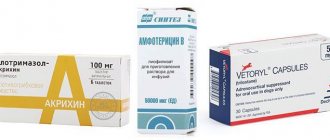Cat owners who are interested in the various symptoms of feline diseases can quickly recognize health problems in their pet. Often the speed of diagnosis and treatment plays the most important role in a cat’s recovery. Unfortunately, felines are susceptible to many types of disease, one group being tail-related diseases.
The reasons for their occurrence can be very different , they do not always even depend on the proper care and concern of the owner. A cat can get sores by injuring itself while jumping, for example.
Particularly complex is tail disease in cats, which manifests itself as neoplasms . This could be vertebral caries or eczema. Such a disease is very difficult to diagnose in the first stages of its course, so cat owners turn to veterinarians, wasting valuable time.
Whatever the disease, it should be treated competently, taking into account the prescriptions of a specialist. In the most difficult cases, treatment is carried out in a veterinary clinic, and only for the period of rehabilitation the animal is sent home.
IMPORTANT! If treatment is carried out at home, the owner must strictly follow all the specialist’s instructions, including recommendations on diet.
Causes of cat tail health problems
The cat may develop a lump on its tail or the base of its tail may become bald . Such problems do not arise without reason. Among the most common causes are various injuries, bruises, and fractures .
- An animal does not always show the pain it experiences when falling, hitting, or being injured. And therefore the owner may not notice the bruise of the tail. And in the future, even a small injury causes the appearance of a tumor, for example.
- Tail disease may be associated with a lack of calcium, which indicates a poorly balanced diet and metabolic disorders .
- Hair loss in the tail area of cats sometimes occurs due to skin infection . Getting a dangerous infection on the skin and into the body can be the most unpredictable; even a person can bring the pathogen into the house on his shoes.
- In the cat's body, the glands that produce fat are disrupted. Because of this, the tail also often peels off - bald spots appear, and there may be oily hair. If the functioning of the glands is disrupted, another phenomenon can be noted - brown plaque under the fur . Over time, the skin becomes wet under this coating and inflammation begins.
If the cat's tail is fat, treatment should be comprehensive .
It will be prescribed by an experienced veterinarian, and the owner only needs to follow all the recommendations.
Seborrhea (dry and oily)
If your pet suddenly starts smelling like a dog, so much so that it becomes difficult to be in the same room with the cat, do not rush to accuse him of being unclean. It is possible that your pet suffers from seborrhea. This is a disease characterized by impaired sebum secretion. If too much of it is secreted, then seborrhea is, accordingly, called “oily.” With insufficient secretion of sebum, a dry type of the disease develops.
Veterinarians are still arguing about the causes of the disease, but to this day many cases must be considered idiopathic, since not a single study has helped to identify a single predisposing factor. In cats, the most common is the “fat” variety.
The clinical picture is quite characteristic. In addition to the unpleasant odor already mentioned above, numerous dandruff appears on the animal’s skin and fur (with the dry variety), or the cat’s tail resembles an unsightly icicle. In the latter case, this happens because the sebum released in incredible volumes simply sticks the hair together.
The intervals between relapses (with proper feeding and good living conditions) can reach several months.
The main predisposing factors are:
- Temperature changes, as well as keeping the cat in rooms with excessively dry air (which is typical for all apartments with central heating).
- It is believed that one of the main reasons for the development of seborrhea in many cases is a variety of allergic reactions.
- The same can be said about diseases of fungal etiology. Pathogenic fungi and yeast have a very bad effect on the condition of the skin.
- “Raw” or “oily” seborrhea is a common consequence of severe hormonal disorders. In particular, it often appears with problems with the thyroid gland.
- Obesity. Firstly, in cats it can also be a consequence of problems with the endocrine glands. Secondly, a “swollen” cat is simply physically unable to take proper care of itself, which makes it much easier for pathogenic fungi to invade its skin. In addition, in such cases, the animal may not have seborrhea, and greasy skin is only a sign of its extreme neglect.
- Diseases of the gastrointestinal tract. If the body does not receive the proper amount of nutrients, micro- and macroelements, the likelihood of developing any diseases becomes many times higher.
- Skin diseases of tick-borne etiology. As a rule, the activity of these parasites leads to the development of a dry type of the disease: mites, gnawing through the outer layers of the skin and actively developing in them, interfere with the normal functioning of the body.
Symptoms and treatment
The symptoms are quite specific, and therefore, as a rule, there are no particular difficulties in identifying the disease. First of all, it is the tail that is affected, which as a result either becomes covered with dandruff, or takes on the appearance of a “greasy icicle.” Abundant dandruff rashes can be found in places where the animal likes to rest; they also become heavily greasy in the case of the oily type of pathology.
Another characteristic sign is very specific, sharp and extremely unpleasant. Experienced owners or veterinarians are able to make a diagnosis as soon as they smell this “aroma.” Note that seborrhea itself does not produce any odor - it is a consequence of the activity of secondary microflora.
As for treatment, it is primarily aimed at eliminating the identified root cause of the disease. Idiopathic seborrhea is treated with special shampoos, which can be purchased at any large pet store. We would recommend consulting with your veterinarian first. It is better when the shampoo is selected by an experienced specialist.
The following products have proven themselves to be effective:
- "Tea tree". It degreases the skin well and has a pronounced anti-inflammatory effect.
- Additionally, any antiparasitic shampoo. It is used in cases where the disease is caused by the activity of fleas, ticks, or other ectoparasites.
- Accordingly, when the disease is fungal in nature, shampoos with an antifungal effect are used.
The main types of diseases in cats
When owners decide why a cat's tail is coming off, they don't always assume a serious illness. Often the appearance of lichen . But the reason for this phenomenon may be more serious; you should definitely take your pet to a veterinary clinic for an accurate diagnosis.
- One of the most serious sores of a cat's tail is vertebral caries . The manifestation of the disease may be a small multiple tumor, which is detected by palpation. The neoplasms are small, they resemble beads strung on a thread. What does this caries lead to without treatment? Over time, both the tip and the entire tail will stop bending. The animal will feel severe discomfort.
- Treatment of osteomyelitis is complex and often requires surgery. The disease can be diagnosed by symptoms such as pain when pressing the tail, lameness of the pet. The tail also rots and painful ulcers appear. The cat is lethargic and its appetite decreases sharply.
- Has the cat's tail fallen off or just part of it? The cause may be an infection on the skin or problems with the production of fat by special glands . A greasy stain that does not go away and is constantly present on the tail area will only confirm the preliminary diagnosis.
- A dangerous situation is the appearance of neoplasms . The tumor is easy to detect when palpating the tail of a pet. And such a problem is a serious reason to contact a veterinarian. What may be hidden under the neoplasm - a malignant tumor, a cluster of parasites, a bag of pus.
Inflammation may occur in the animal's bone marrow due to infection or dangerous injury. As a result, osteomyelitis will develop.
ATTENTION! If you find a lump on your pet's tail, you should immediately contact a veterinarian.
Treatment of diseases that cause baldness
Bald areas of the tail are not only an aesthetic issue. Usually this phenomenon is caused by disruption of the internal glands. Most often, the disease goes away on its own, but bald patches greatly worsen the appearance of the animal. The veterinarian will help you choose a drug option that will speed up recovery.
But in some cases, a shabby tail becomes a big problem, since the exposed skin becomes very irritated and inflamed. Bacteria actively develop on bald spots. And over time, the cat begins to experience severe discomfort and scratches its inflamed skin.
How to help an animal? The main principle of treatment is the removal of excess fat from the skin and fur, as well as antibacterial treatment of the affected area . If you carry out all the measures prescribed by your doctor correctly, over time you can reduce the problem to a minimum. You definitely need to find out why excess fat and bald spots appeared.
During the treatment period, you need to use cat shampoos that contain oatmeal and natural salicylic acid. A good effect is achieved by wiping the bald area with a swab lightly moistened with alcohol. Alcohol should be used carefully, as it can only worsen the condition of the skin .
INTERESTING! If your cat doesn't like bathing, you can sprinkle cornstarch on oily and bald areas. The procedure is carried out once a day, not more often.
Signs of the disease
Depending on the severity of the problem, hyperplasia of the sebaceous glands can manifest itself in different ways:
- In the area of the rump and at the base of the tail, the fur becomes greasy in appearance: the fur is dull and unkempt, the hair is stuck together in “icicles.”
- The hair breaks off at the base or falls out, and areas of baldness appear - bald spots.
- Lumps form on the skin, sometimes comedones (blackheads) and pimples. There is severe dandruff (inflamed skin covered with scales).
Tail injuries and their consequences
If a cat falls from a height or accidentally gets run over by a car or even a person's feet with its tail, injury to this organ can lead to serious consequences.
At the slightest suspicion of injury in a kitten or an adult whose tail has darkened after a blow, you need to give the animal an x-ray , because with a severe fracture, tissue necrosis can begin, which cannot be cured with simple medications. The doctor may prescribe wearing a splint or plaster cast. After treatment, a re-examination with x-rays is carried out.
Ulcers - disease diagnosis, treatment
One of the symptoms of a complex disease is ulcers on the tail of a pet. The skin in this place becomes wet, rots, and the affected area increases. If at first the ulcer only appears under the tail, then rotting areas may appear on the entire tail and back.
You don’t need to treat ulcerated areas yourself, because a variety of infections can cause rotting. Is it possible to go to a veterinary clinic soon? You can clean the wound that is rotting from the liquid yourself and treat it with an antiseptic intended specifically for cats. Then ointment is applied to the wound and a bandage is applied on top.
To prevent the cat from scratching the wound, which is already bleeding or simply rotting, you need to put a special cone-shaped protective circle on it. This design is removed during feeding.
ATTENTION! Healing ulcers can be very itchy; to relieve discomfort, you can lightly comb the cat's fur around the wound. This will calm the furry patient a little and relieve the feeling of discomfort.
Ulcers occur more often in representatives of short-haired breeds. A small wound can subsequently lead to necrosis of the tissues and vertebrae of this part of the animal’s body. Among the most dangerous complications are also gangrene caused by poor circulation and blood poisoning . An ulcer cannot be ignored, relying on the cat’s ability to self-medicate.
Tail ulcer
Short-haired cats often suffer from ulcers that form on their tails. These ulcers can be located throughout the tail, including at the root of the tail, which can cause necrosis of the vertebrae of the caudal process.
This disease is specific and requires strict pharmacological treatment, as well as special recommendations to the owner for treating the cat at home. The process of treating a tail ulcer also includes cleaning it of dirt and, if formed, a crust. After this procedure, the affected area of the tail should be treated with antiseptic powder and lubricated with a special product prescribed by the veterinarian. Kubatol aerosol is often used for these purposes. After such treatment, the affected area is lubricated with ointment. This can be syntomycin or streptomycin ointment, or liquid Vishnevsky liniment. After treatment, the affected area of the tail should be wrapped with a light bandage for 5 days for protection.
All this time, you need to periodically comb the fur in areas located near the affected area to prevent itching. During the procedures, it is better to protect yourself with the help of a protective circle or a “plant pot” type muzzle.
Any tail disease can only be treated under the supervision of a veterinarian.
If this disease is neglected, your pet may develop gangrene. Therefore, when you first suspect the appearance of an ulcer, you need to take the necessary measures without delay. Otherwise, a situation may arise in which there is no other choice but to amputate the tail.
Prevention of tail diseases
If injuries or tumors are difficult to prevent, then owners can protect their pet from problems due to excess oil on the skin. You should constantly care for the animal's fur, not only when bald areas appear . An excellent remedy is fish oil; it should be added to the food.
After a cat is injured, it is important to monitor its health - take it to a doctor for examination, and get an x-ray of the affected organs. Immediately after injury, you can carefully palpate the cat’s tail and pay attention to painful areas. If there is an open wound, you need to act immediately. You can apply ice to the sore tail ; it will relieve the pain a little and allow you to get to the veterinary clinic .
A balanced diet allows you to avoid a lack of calcium in the diet, but this deficiency is the cause of the development of bone caries.



